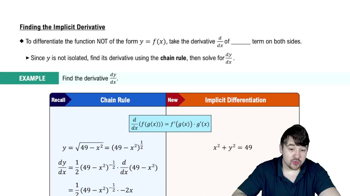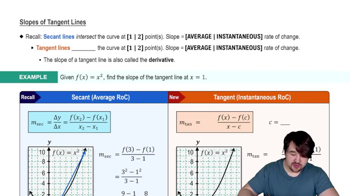Table of contents
- 0. Functions7h 52m
- Introduction to Functions16m
- Piecewise Functions10m
- Properties of Functions9m
- Common Functions1h 8m
- Transformations5m
- Combining Functions27m
- Exponent rules32m
- Exponential Functions28m
- Logarithmic Functions24m
- Properties of Logarithms34m
- Exponential & Logarithmic Equations35m
- Introduction to Trigonometric Functions38m
- Graphs of Trigonometric Functions44m
- Trigonometric Identities47m
- Inverse Trigonometric Functions48m
- 1. Limits and Continuity2h 2m
- 2. Intro to Derivatives1h 33m
- 3. Techniques of Differentiation3h 18m
- 4. Applications of Derivatives2h 38m
- 5. Graphical Applications of Derivatives6h 2m
- 6. Derivatives of Inverse, Exponential, & Logarithmic Functions2h 37m
- 7. Antiderivatives & Indefinite Integrals1h 26m
- 8. Definite Integrals4h 44m
- 9. Graphical Applications of Integrals2h 27m
- 10. Physics Applications of Integrals 2h 22m
4. Applications of Derivatives
Implicit Differentiation
Problem 3.8.46a
Textbook Question
45–50. Tangent lines Carry out the following steps. <IMAGE>
a. Verify that the given point lies on the curve.
x³+y³=2xy; (1, 1)
 Verified step by step guidance
Verified step by step guidance1
First, substitute the given point (1, 1) into the equation of the curve x³ + y³ = 2xy to verify if it satisfies the equation.
Substitute x = 1 and y = 1 into the equation: (1)³ + (1)³ = 2(1)(1).
Calculate the left side of the equation: 1 + 1 = 2.
Calculate the right side of the equation: 2 * 1 * 1 = 2.
Since both sides of the equation are equal, the point (1, 1) lies on the curve.
 Verified video answer for a similar problem:
Verified video answer for a similar problem:This video solution was recommended by our tutors as helpful for the problem above
Video duration:
1mPlay a video:
Was this helpful?
Key Concepts
Here are the essential concepts you must grasp in order to answer the question correctly.
Implicit Differentiation
Implicit differentiation is a technique used to differentiate equations where the dependent and independent variables are not explicitly separated. In the context of the equation x³ + y³ = 2xy, we differentiate both sides with respect to x, treating y as a function of x. This allows us to find the derivative dy/dx, which is essential for determining the slope of the tangent line at a specific point.
Recommended video:

Finding The Implicit Derivative
Tangent Line
A tangent line to a curve at a given point is a straight line that touches the curve at that point without crossing it. The slope of the tangent line is equal to the derivative of the function at that point. To find the equation of the tangent line, we use the point-slope form, which requires the slope (found via differentiation) and the coordinates of the point on the curve.
Recommended video:

Slopes of Tangent Lines
Verifying Points on Curves
Verifying that a point lies on a curve involves substituting the coordinates of the point into the equation of the curve. If the left-hand side equals the right-hand side after substitution, the point is confirmed to be on the curve. In this case, substituting (1, 1) into the equation x³ + y³ = 2xy helps establish that the point is indeed on the curve before proceeding to find the tangent line.
Recommended video:

Summary of Curve Sketching

 5:14m
5:14mWatch next
Master Finding The Implicit Derivative with a bite sized video explanation from Nick
Start learningRelated Videos
Related Practice


